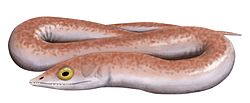You can help expand this article with text translated from the corresponding article in French. (January 2025)Click [show] for important translation instructions.
|
| Densignathus Temporal range: Late Devonian | |
|---|---|
| Scientific classification | |
| Domain: | Eukaryota |
| Kingdom: | Animalia |
| Phylum: | Chordata |
| Clade: | Sarcopterygii |
| Clade: | Tetrapodomorpha |
| Clade: | Stegocephali |
| Genus: | † Densignathus Daeschler, 2000 |
| Type species | |
| †D. rowei Daeschler, 2000 | |
Densignathus is an extinct genus of early stem-tetrapod from the Late Devonian-aged Catskill Formation of Pennsylvania in the United States. A lower jaw has been found from the Red Hill fossil site, which is known for a diversity of lobe-finned fishes and other early tetrapods like Hynerpeton . The type species, Densignathus rowei, was named in honor of paleontologist Norman Douglas Rowe in 2000. [1]





